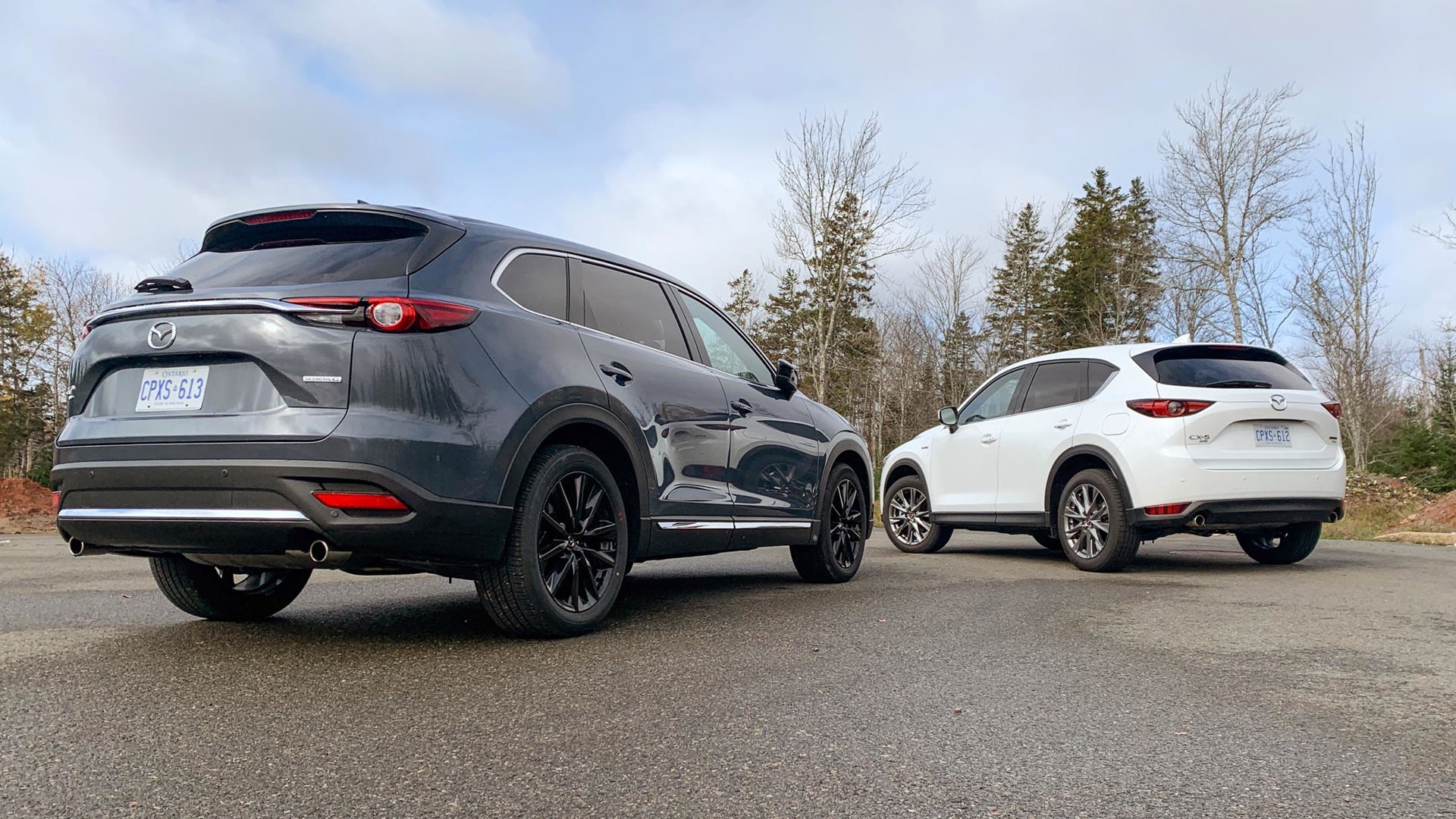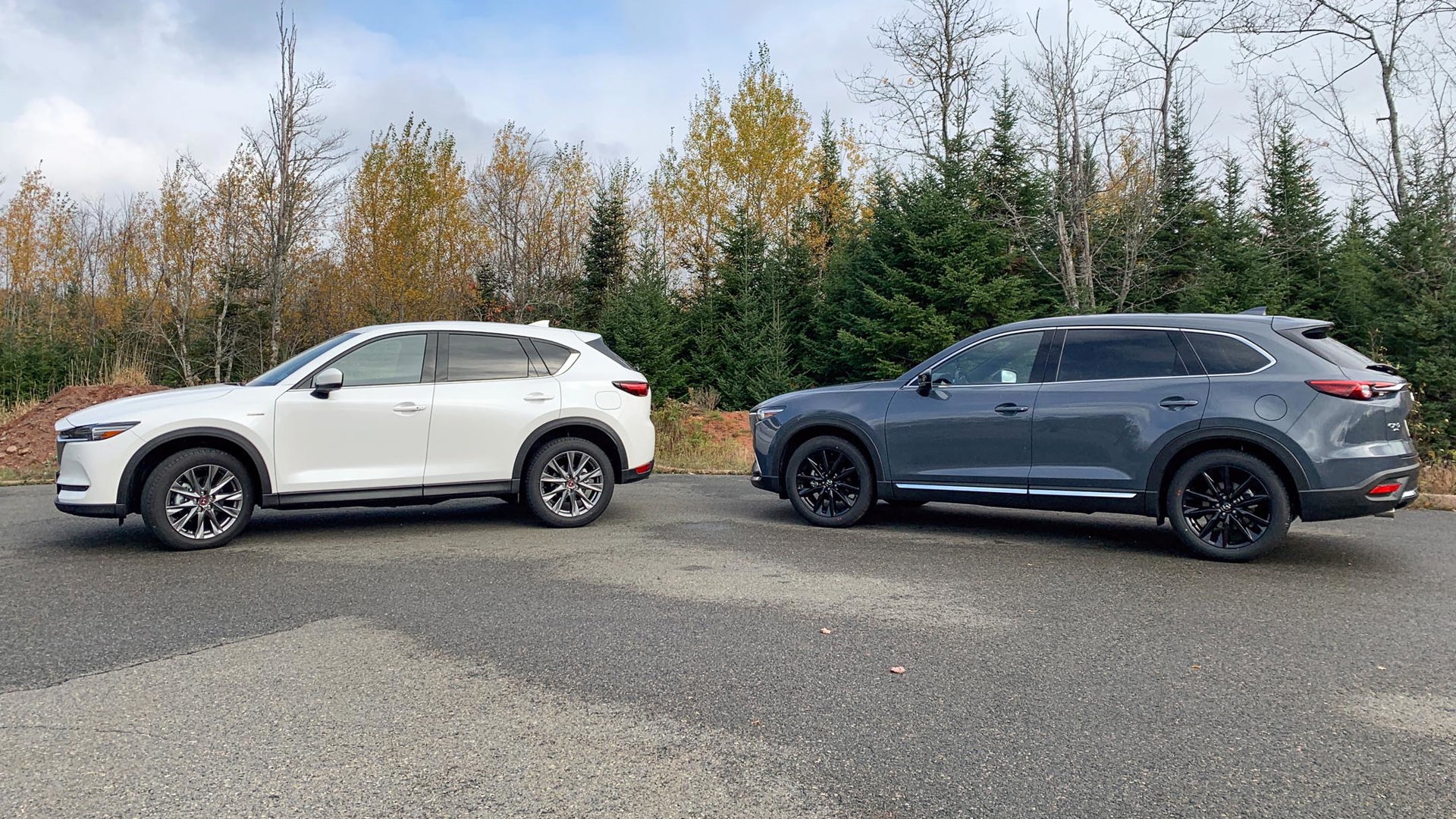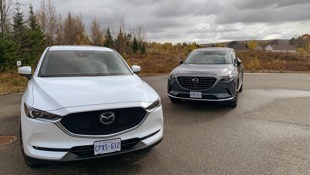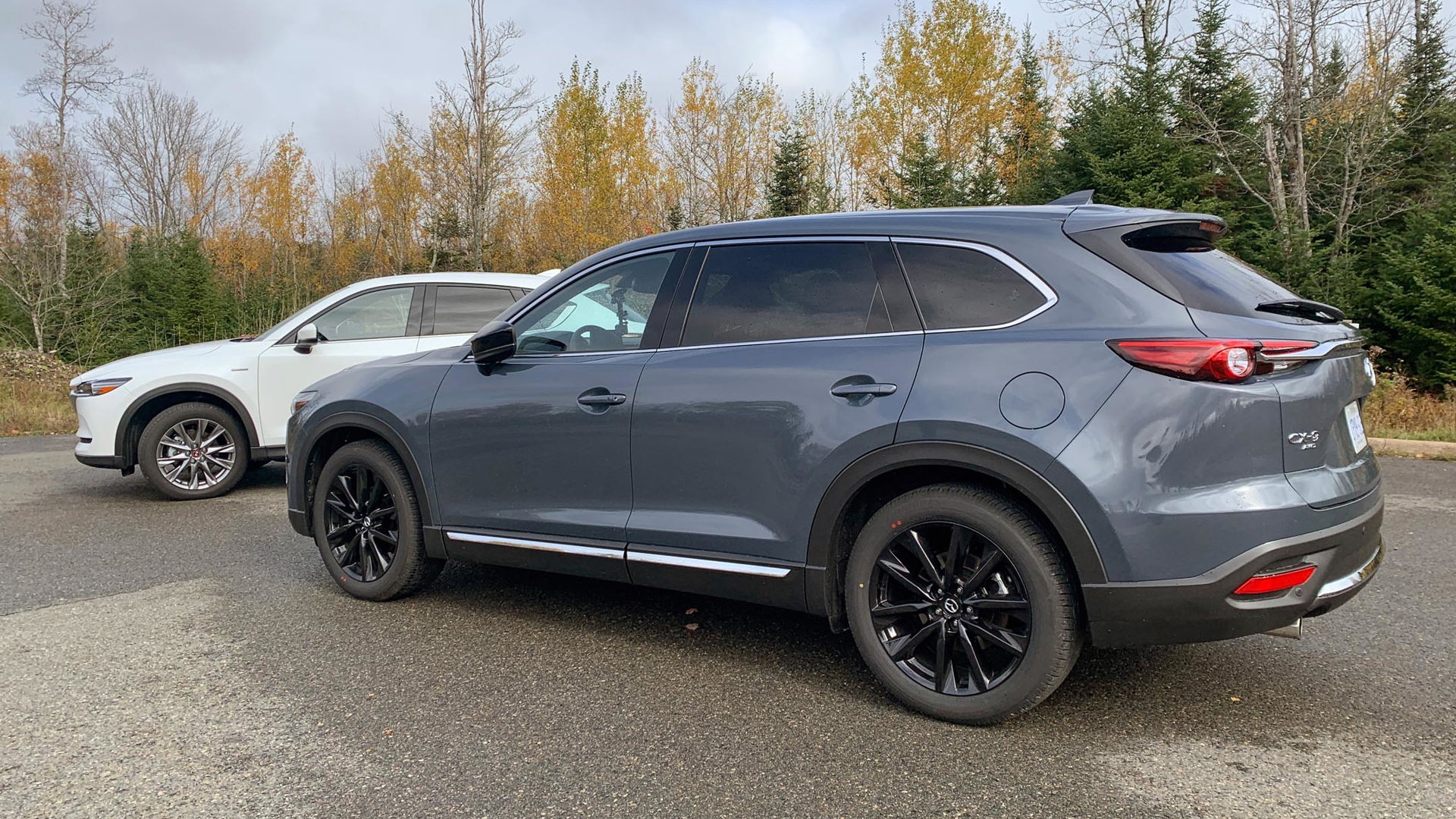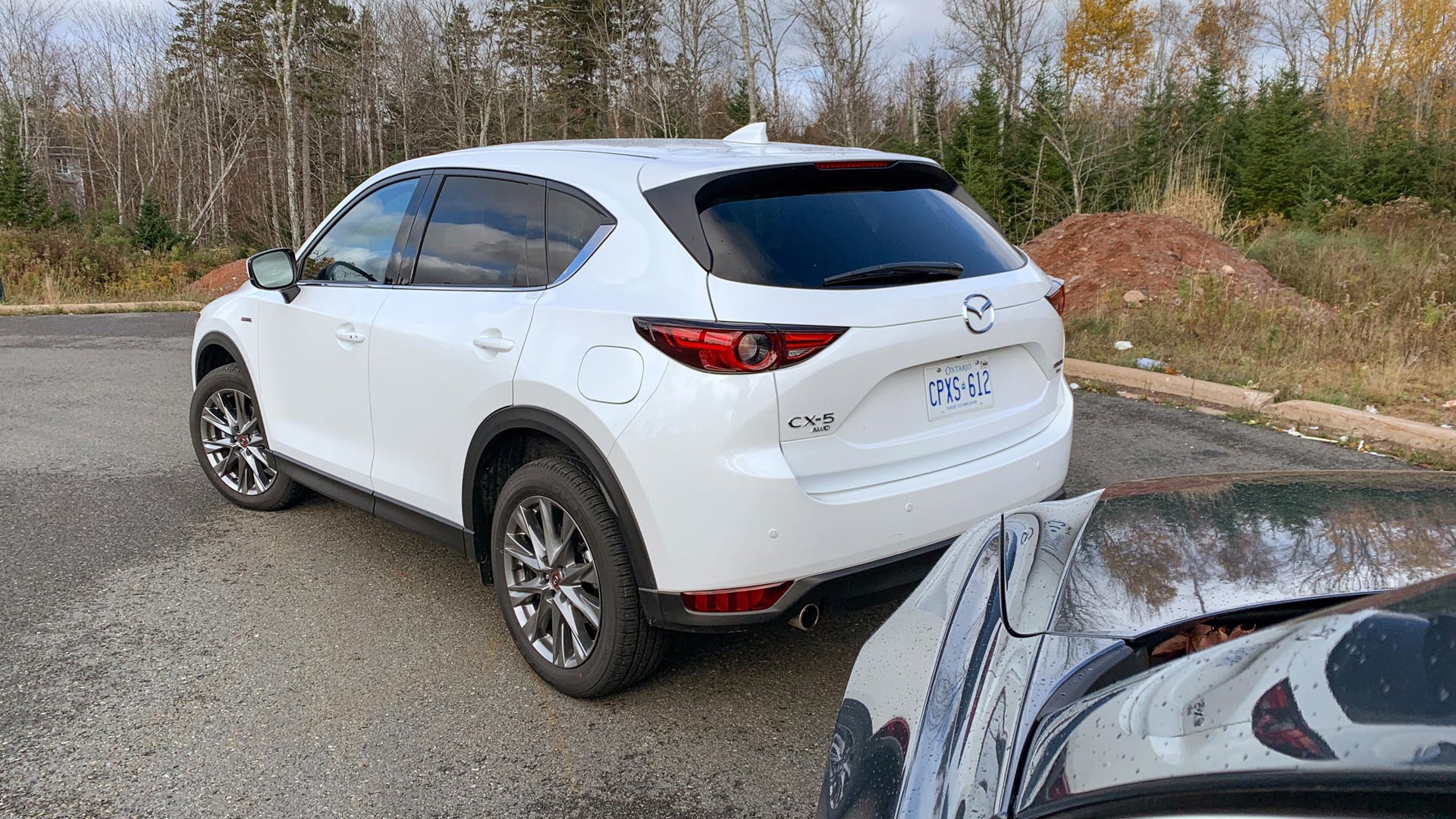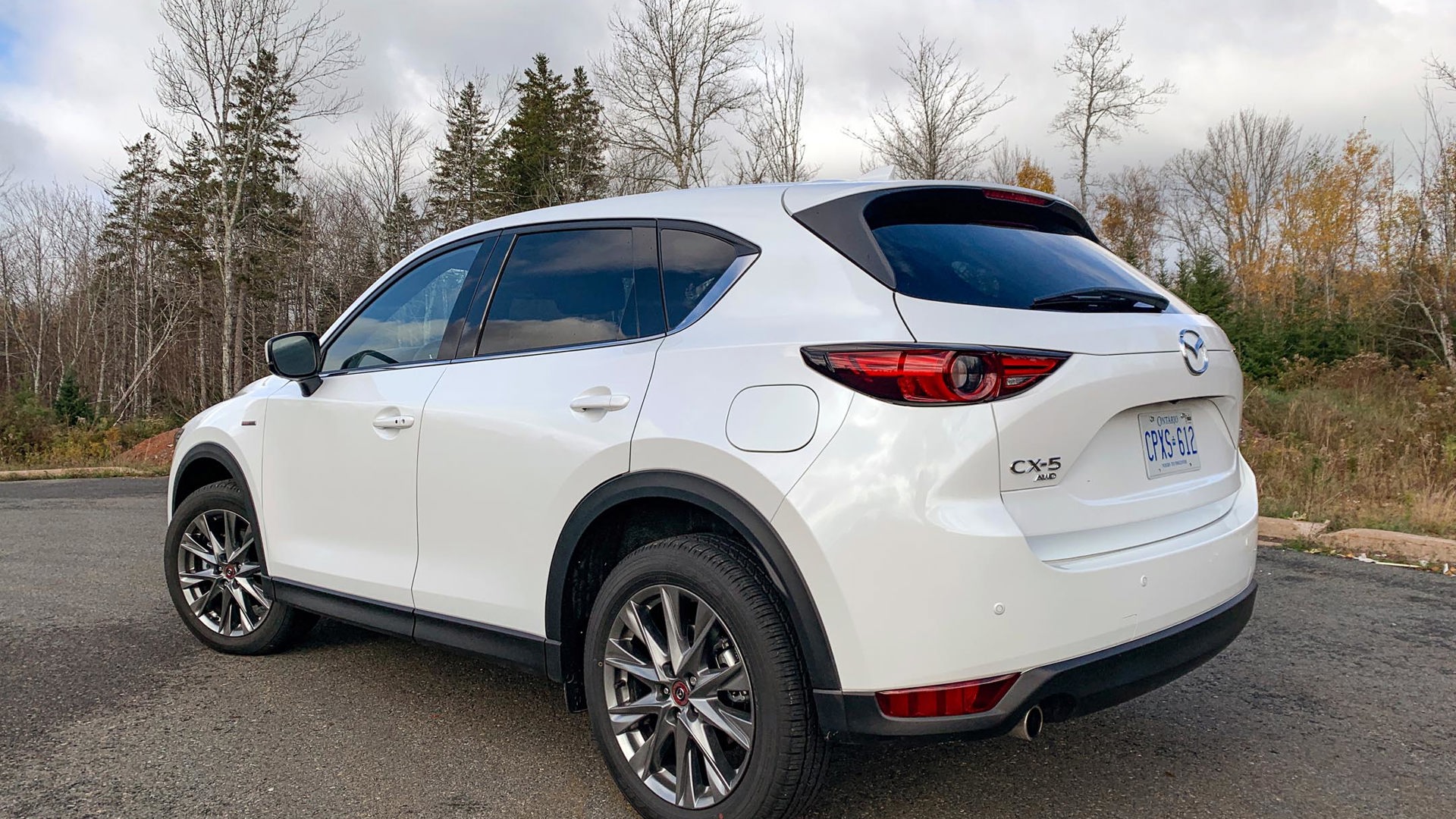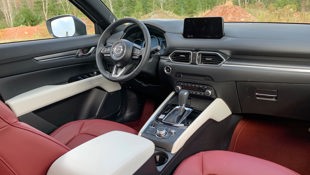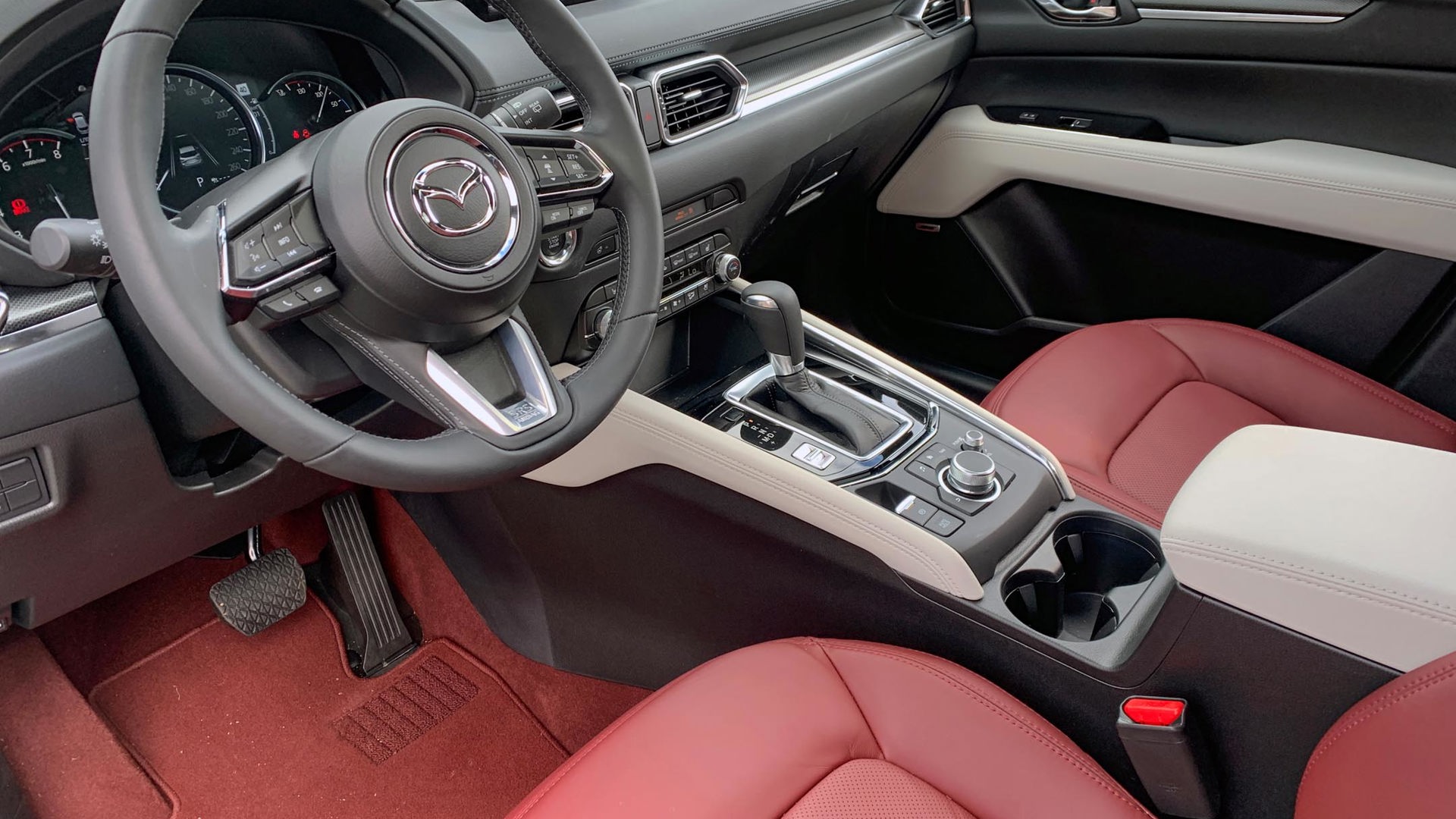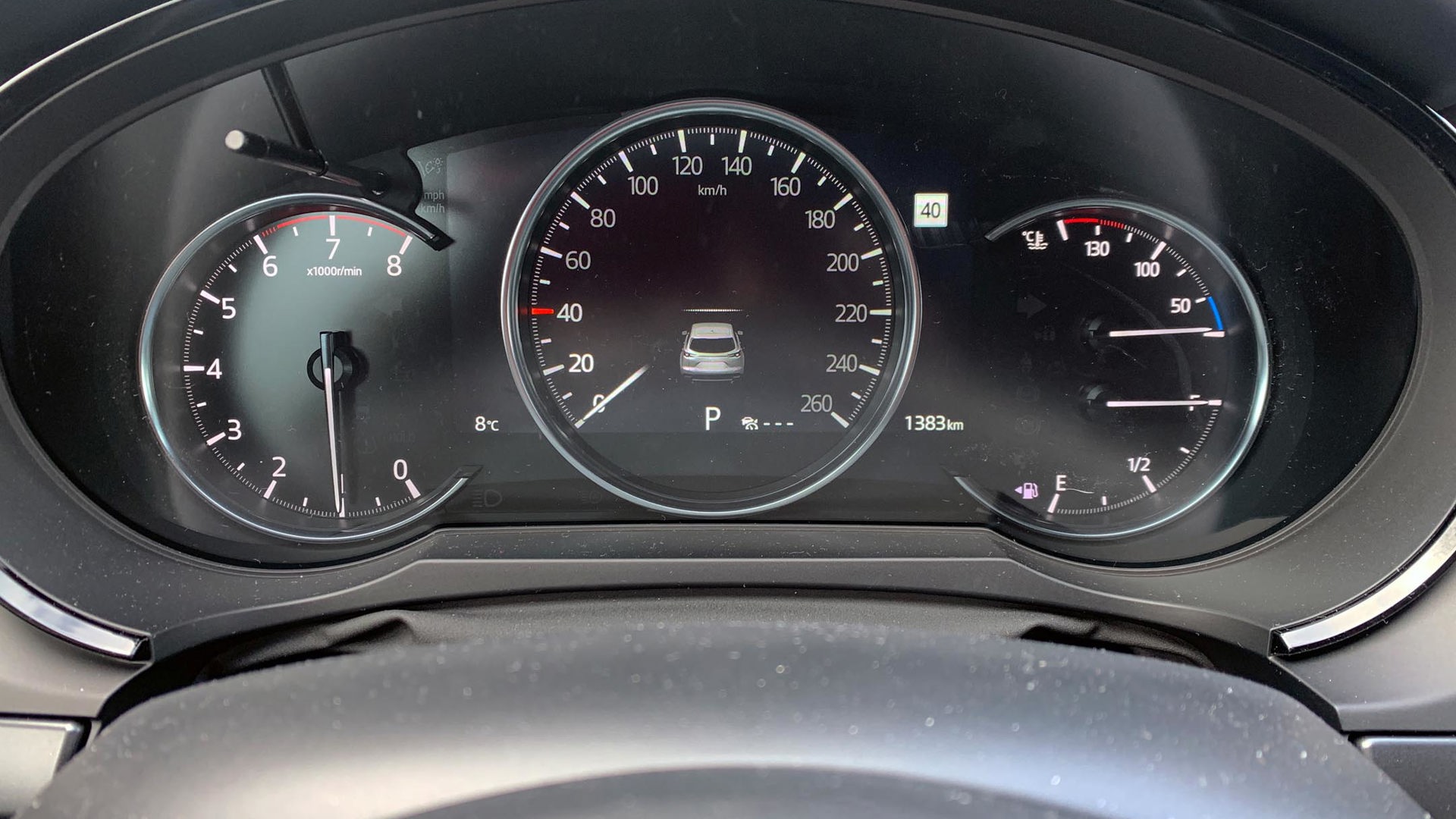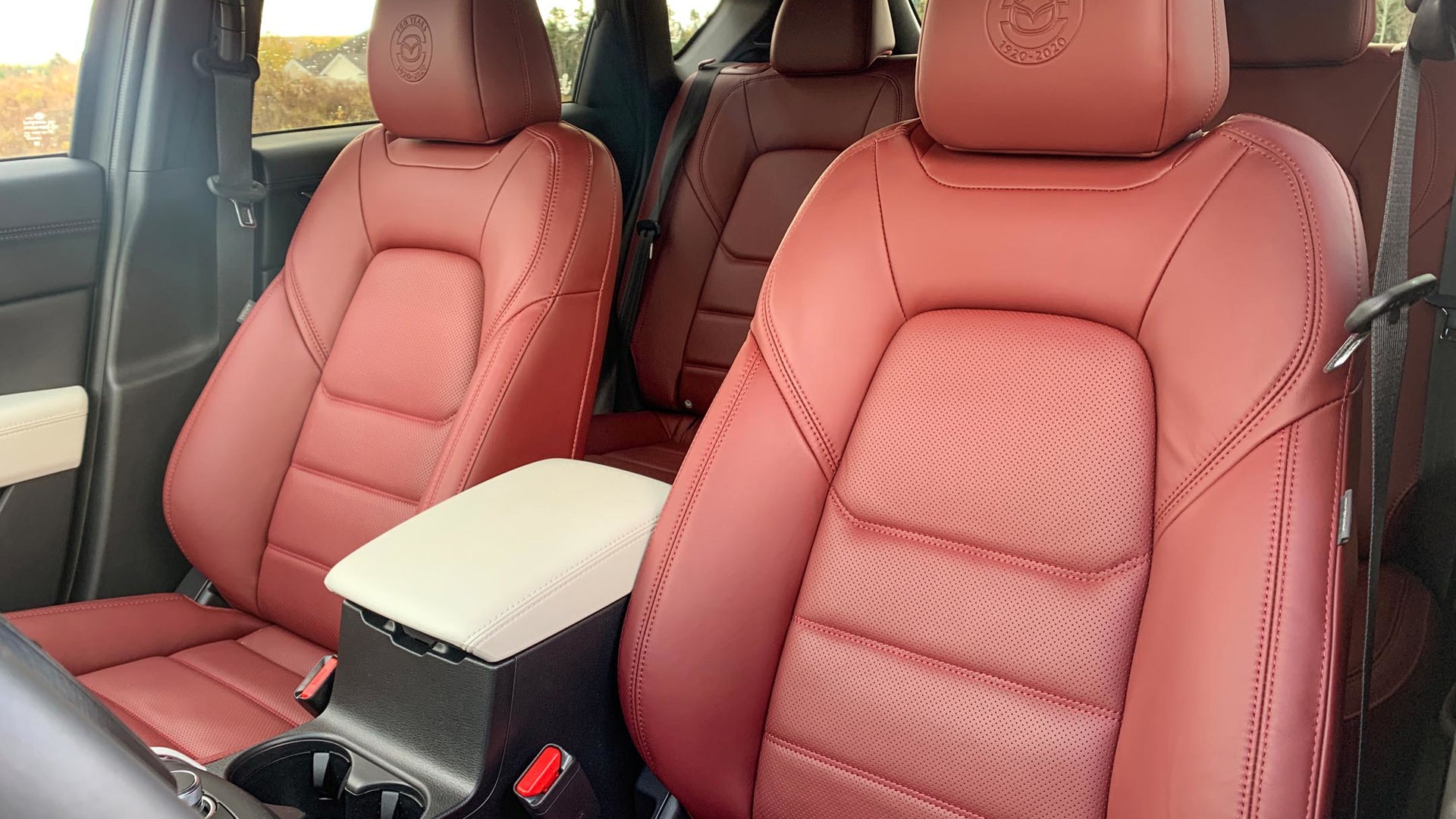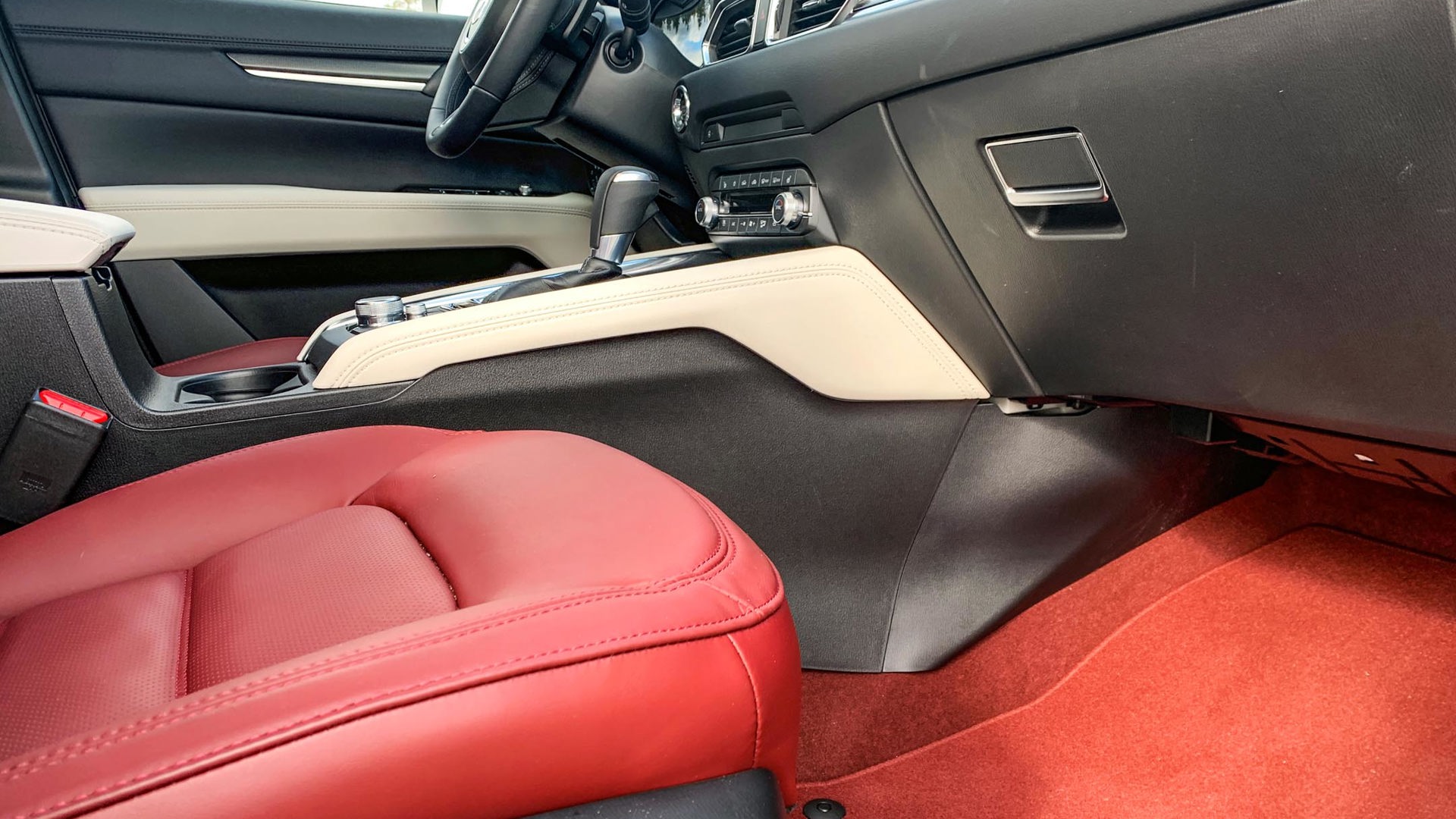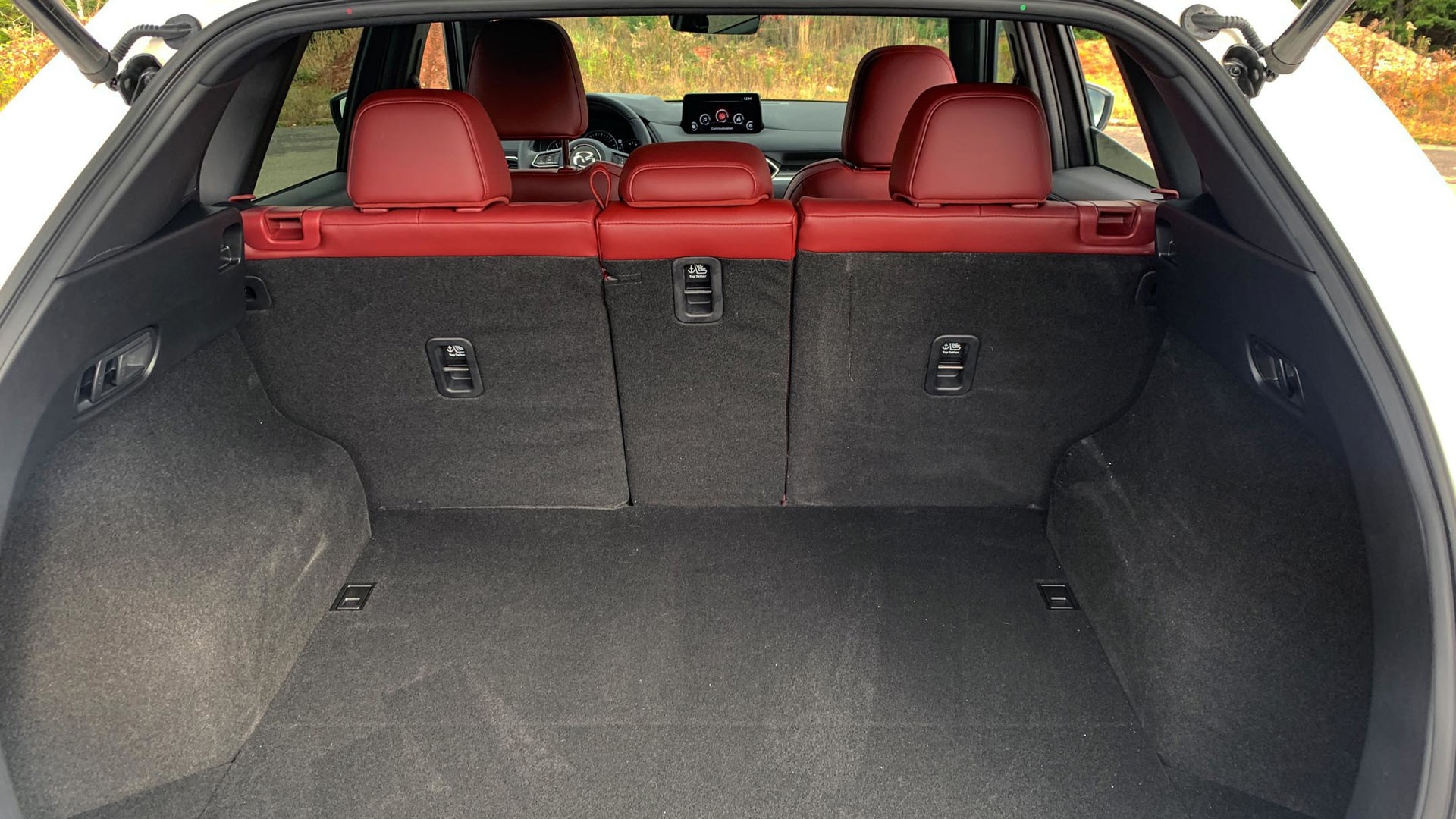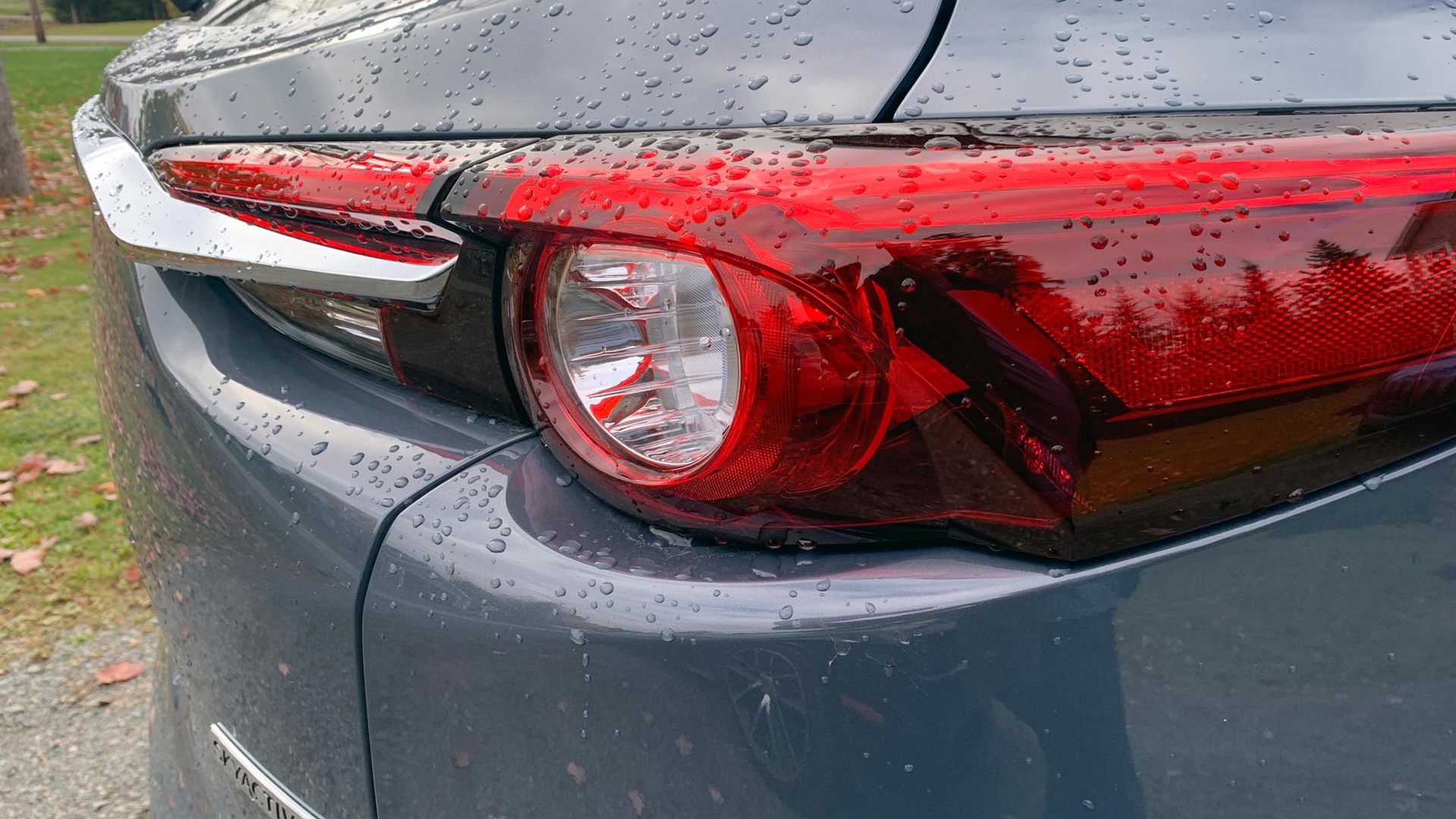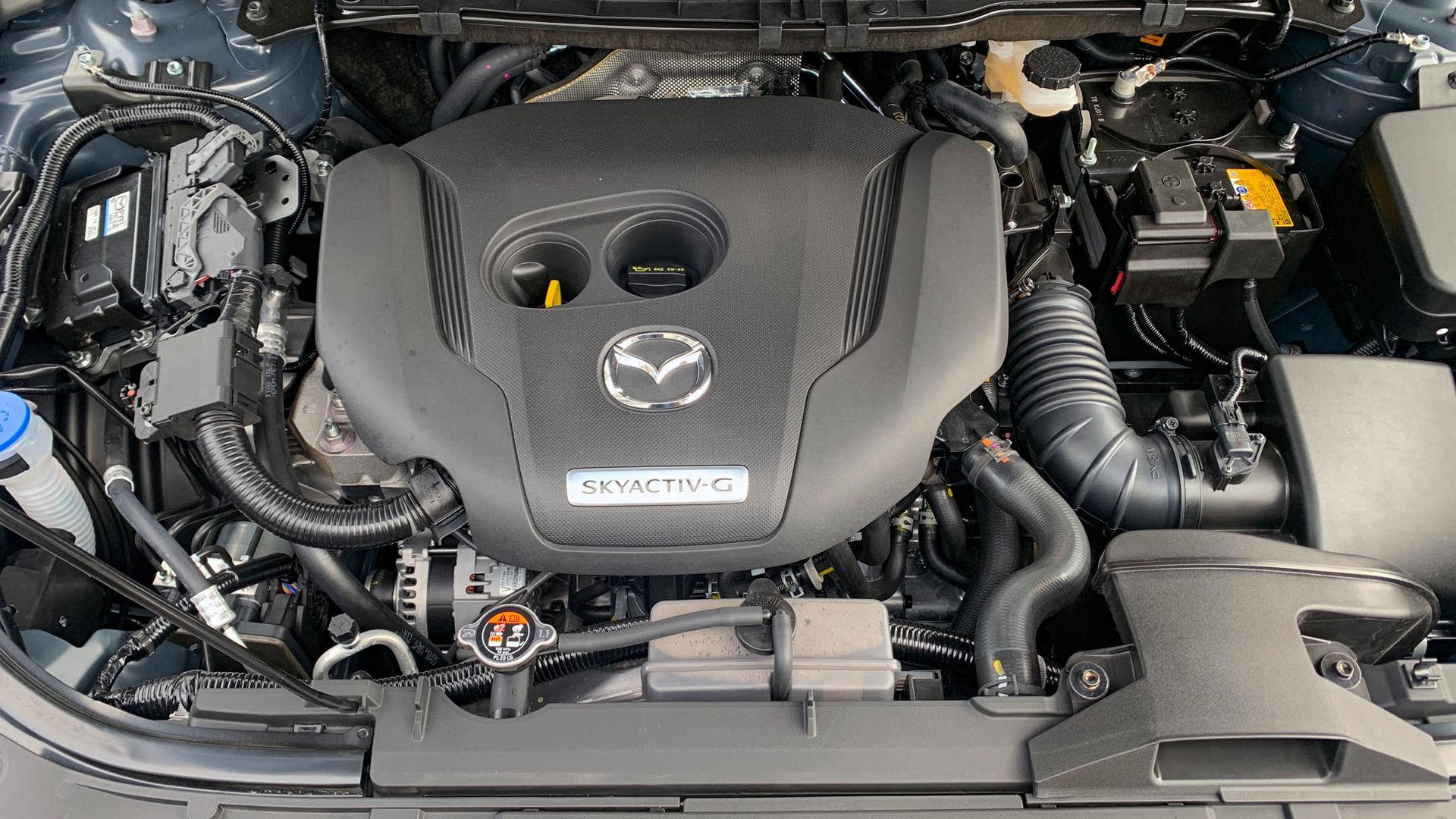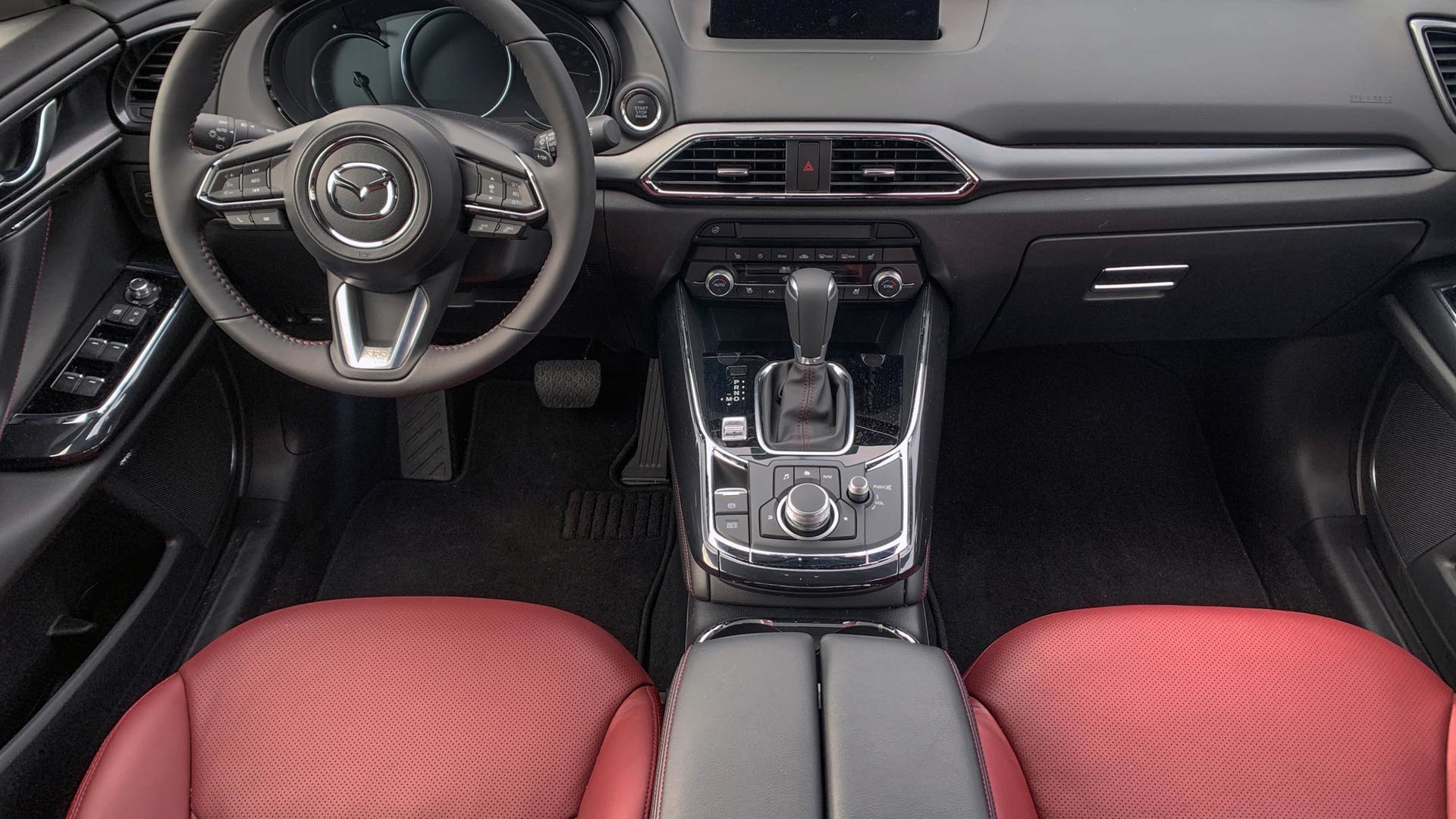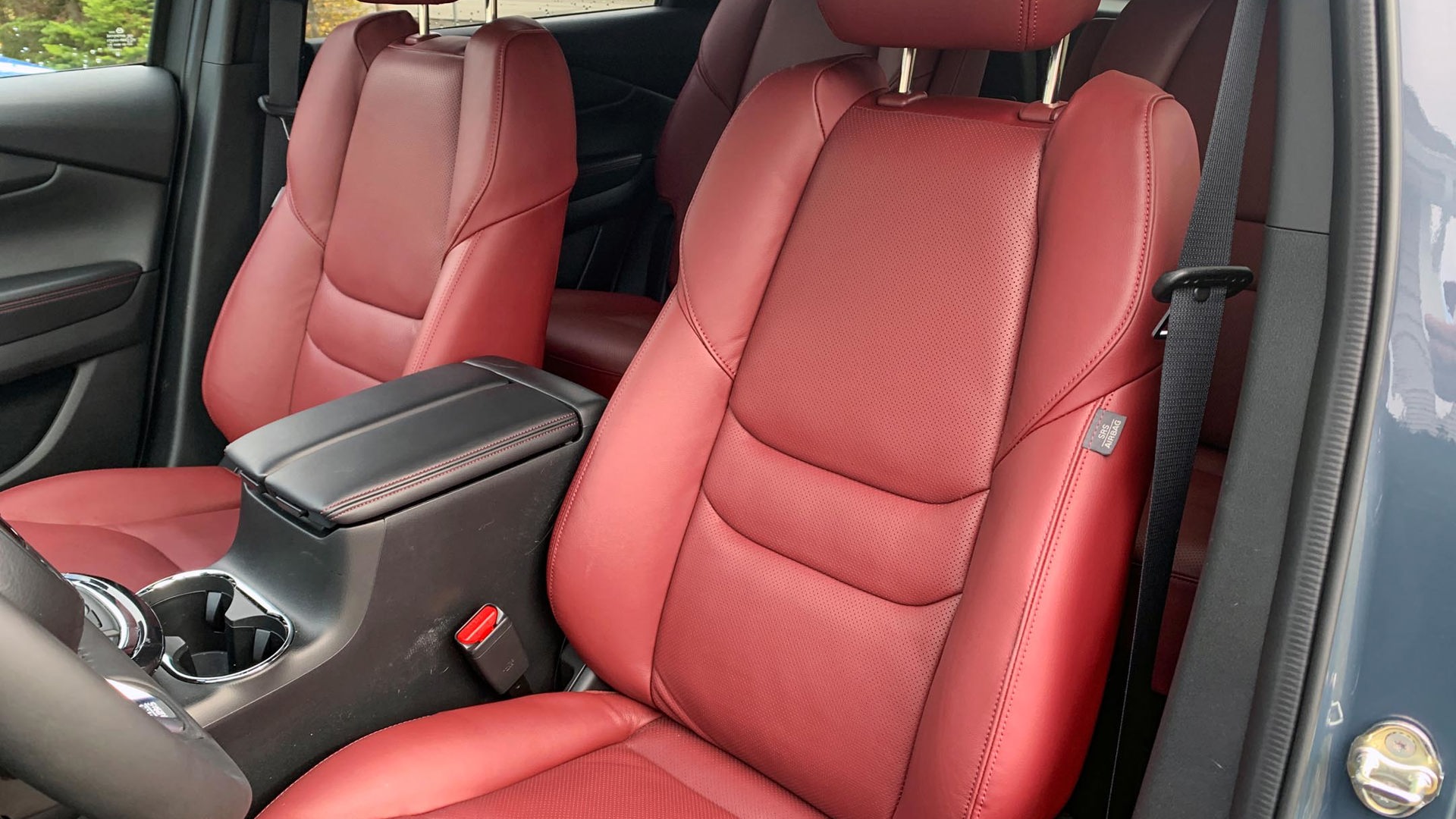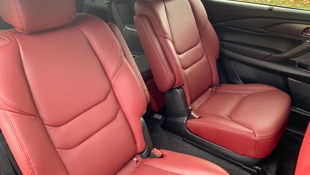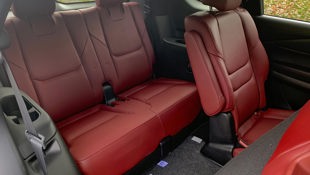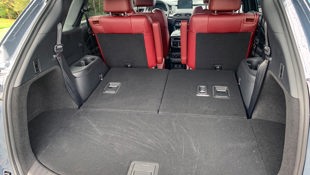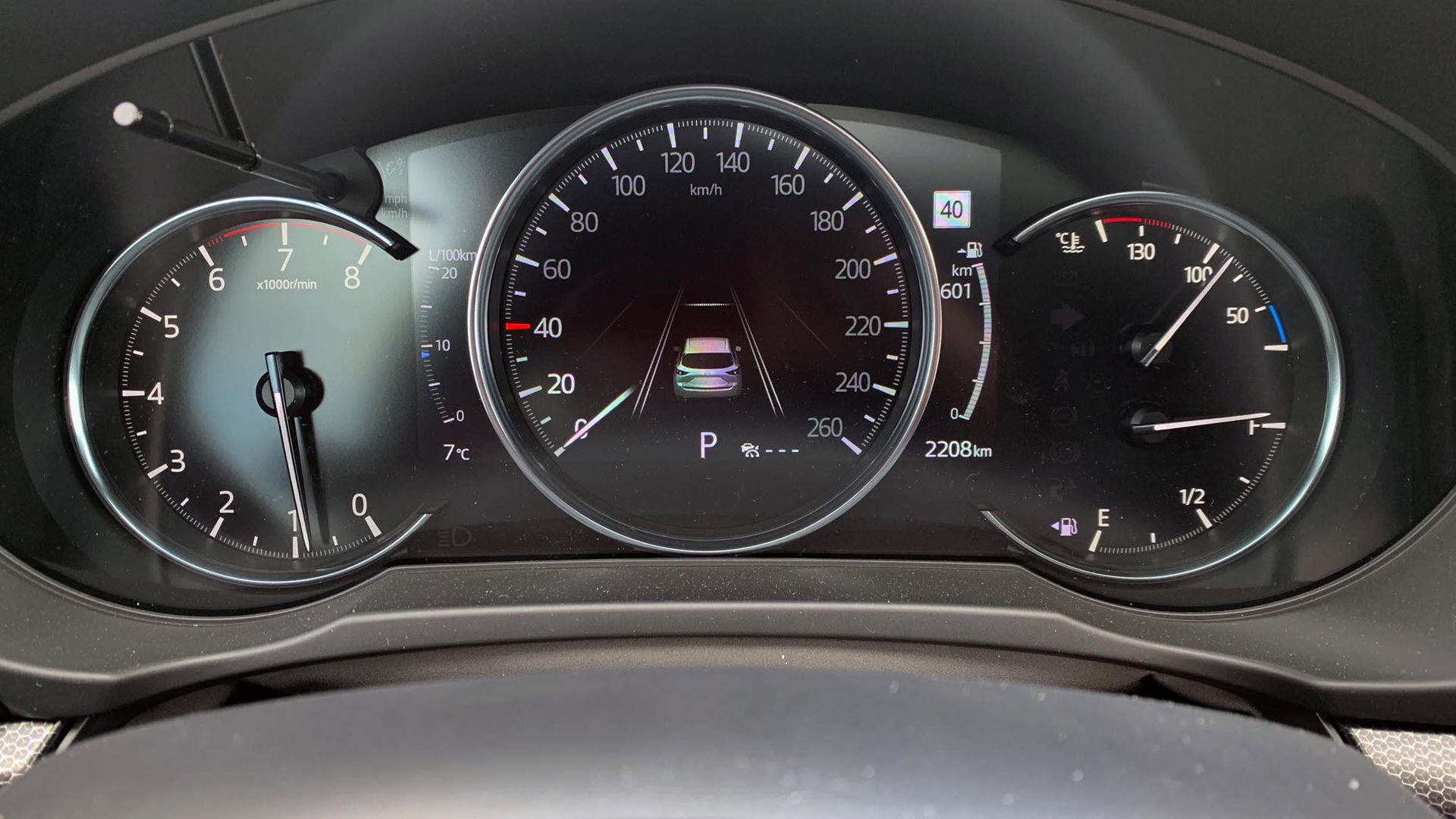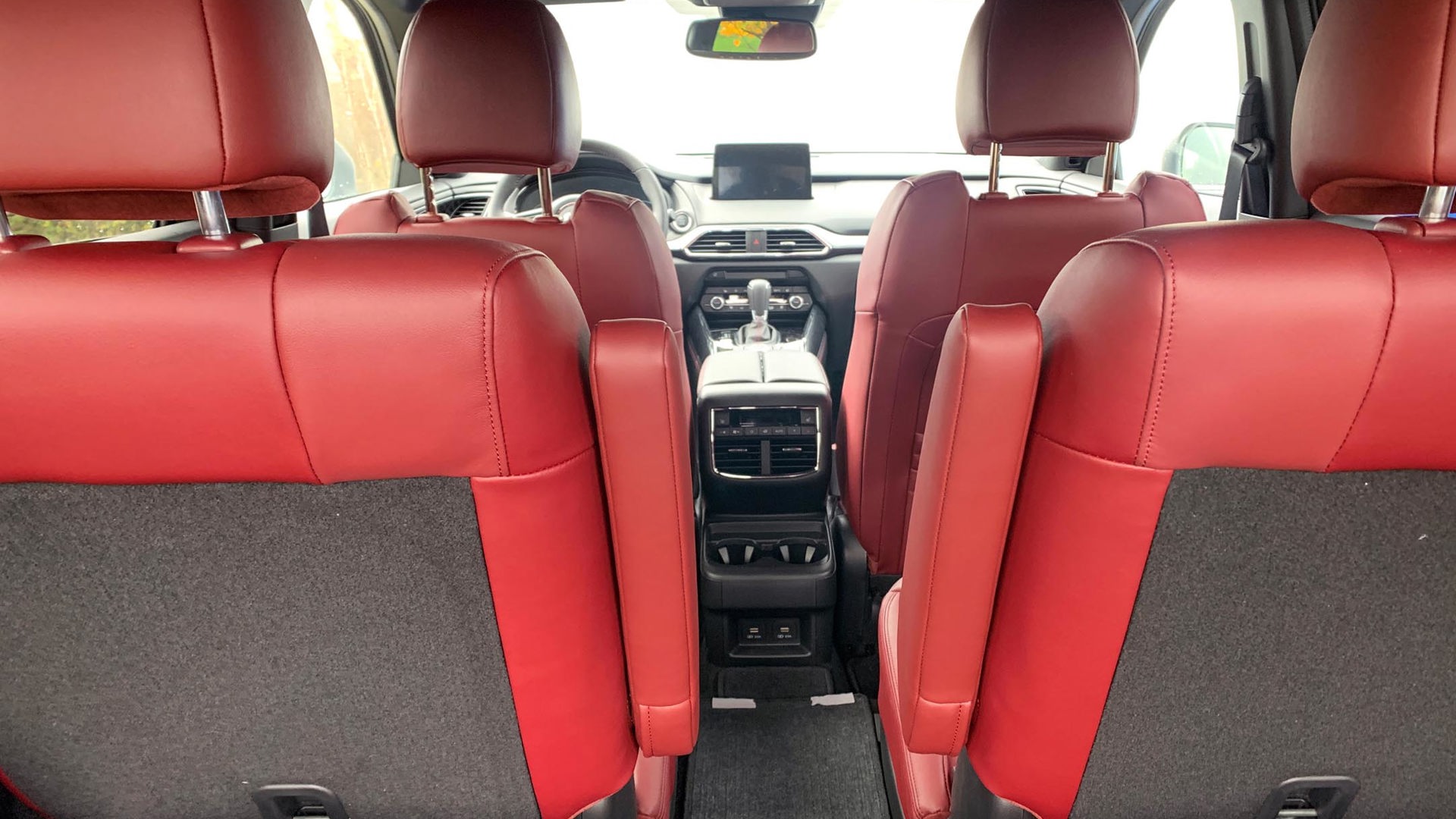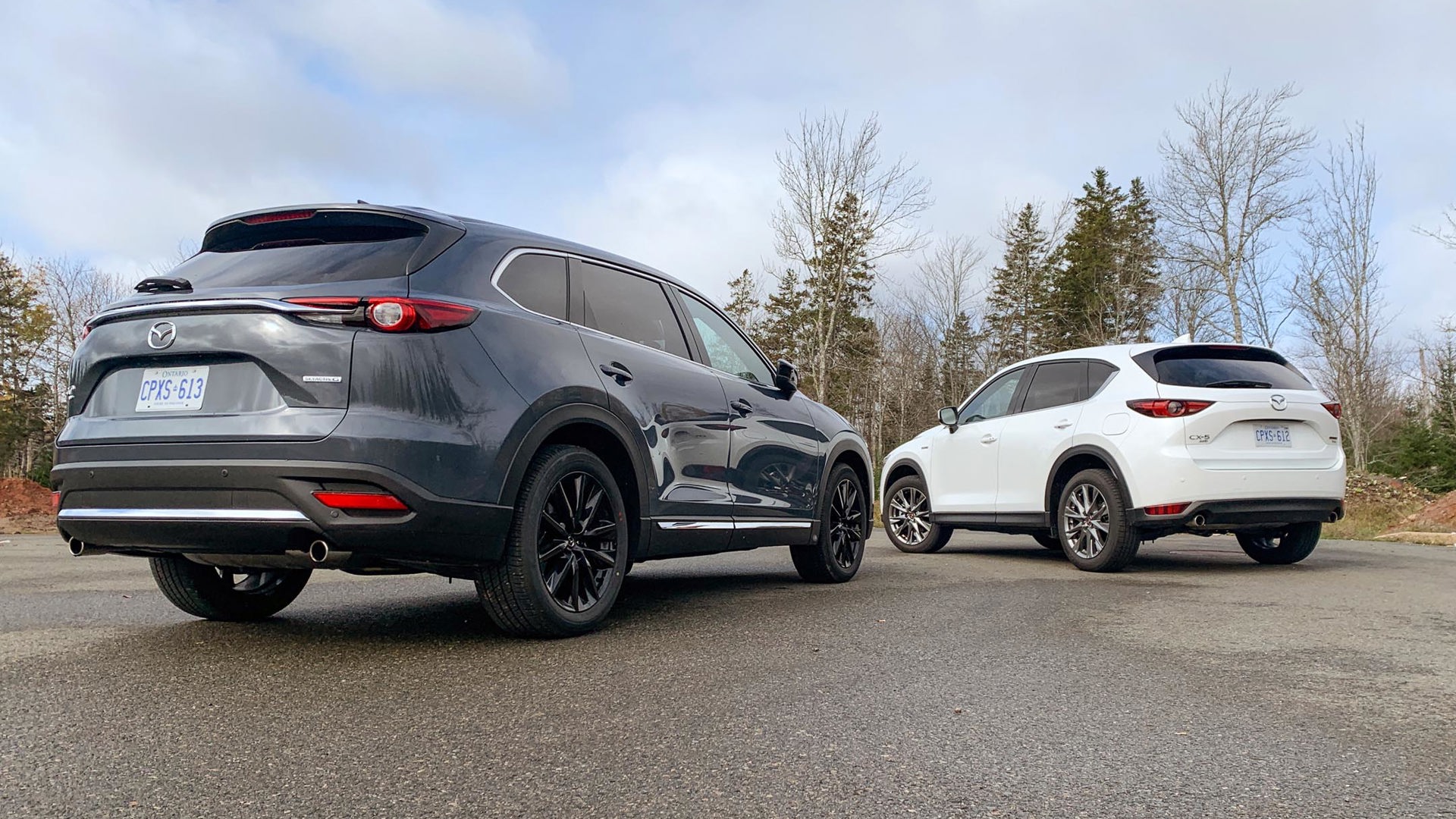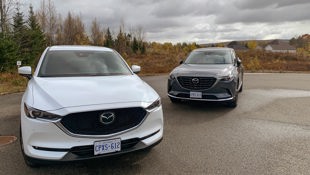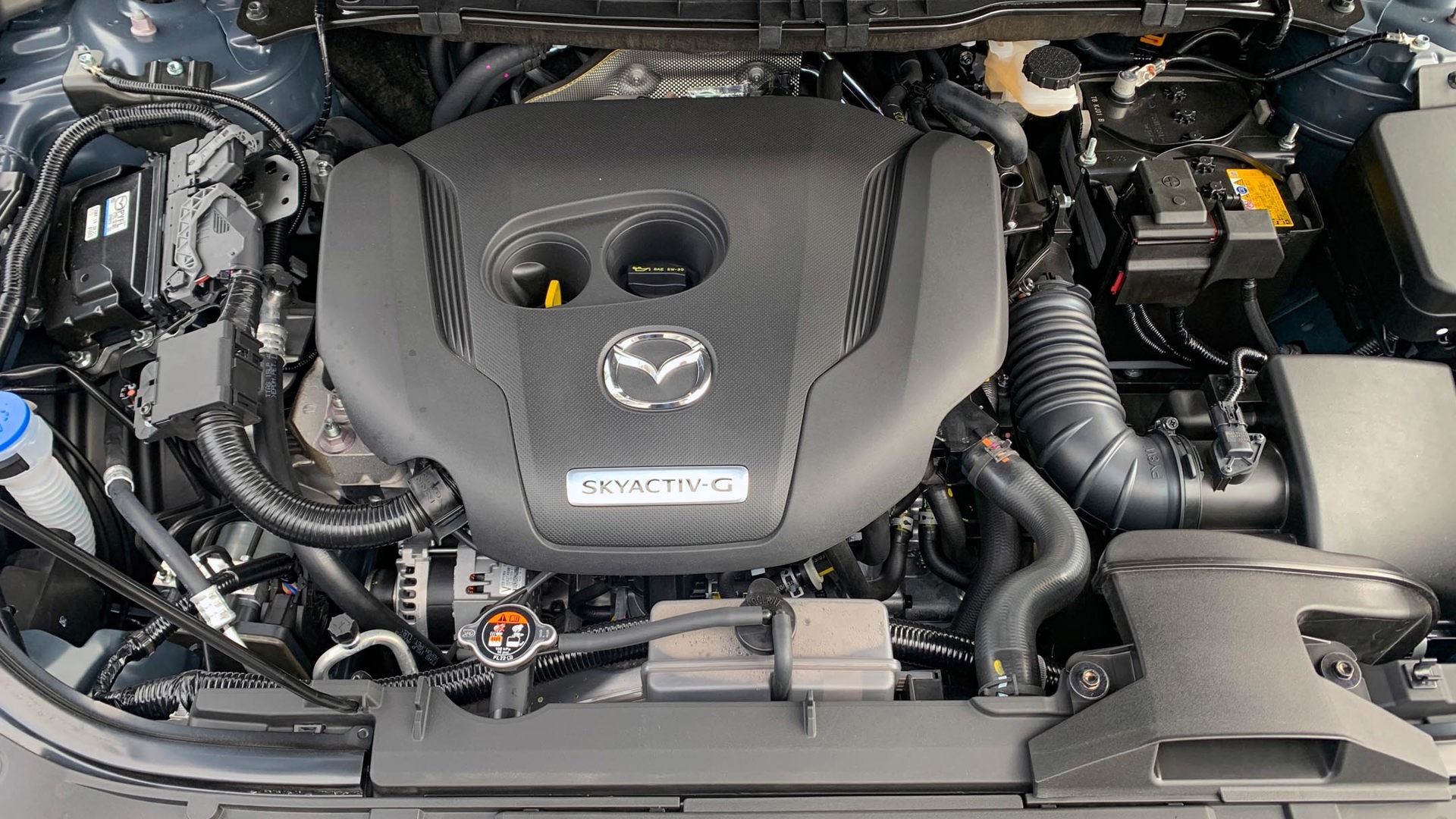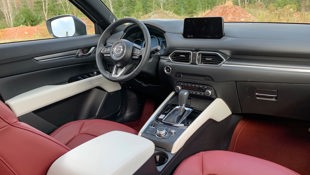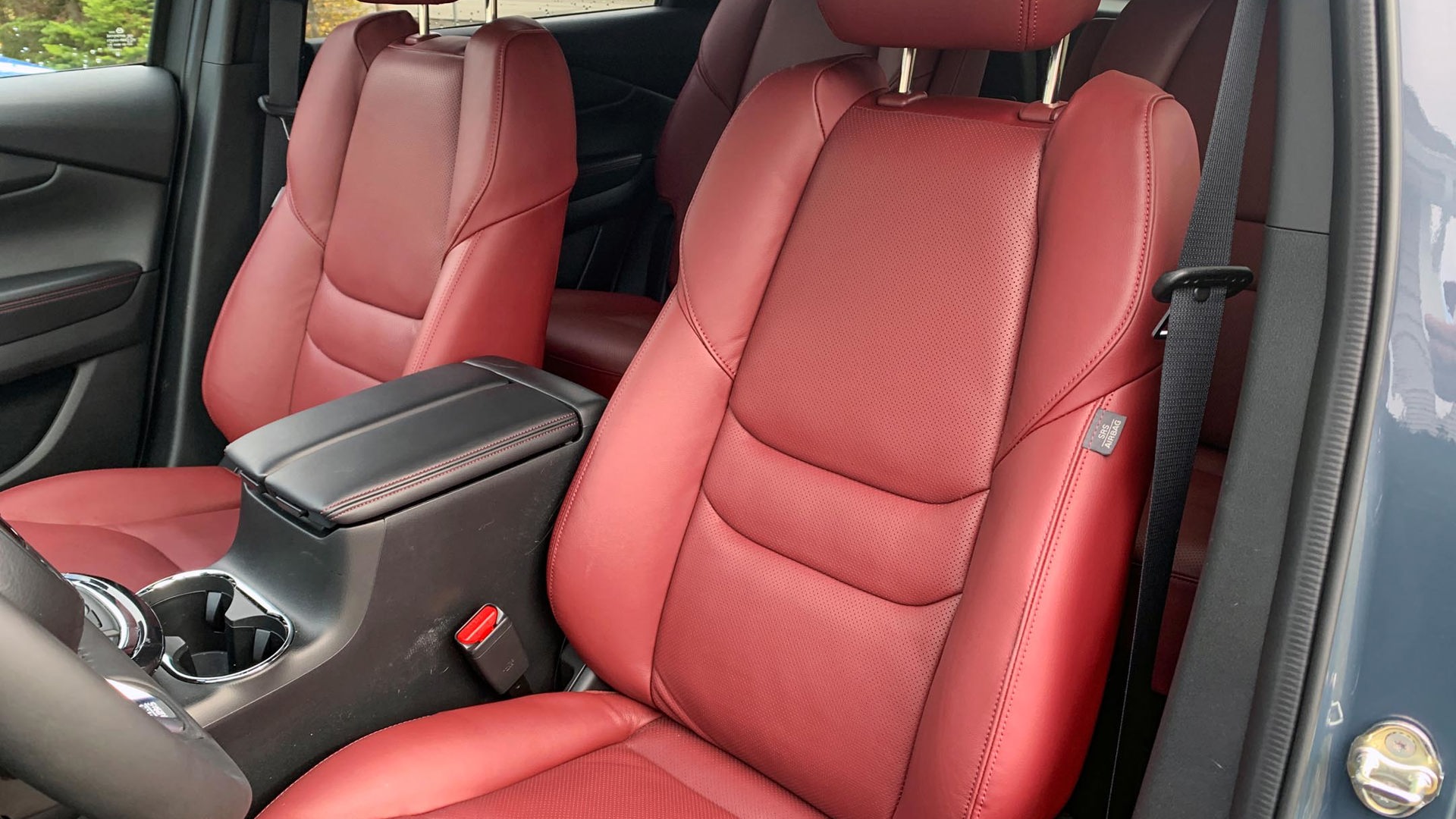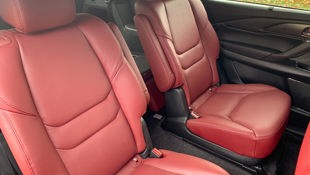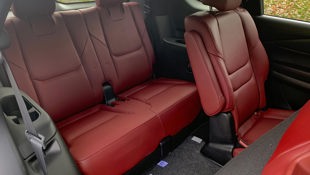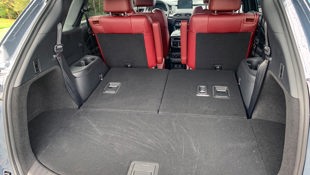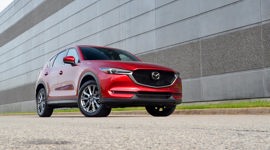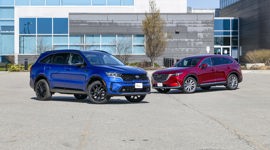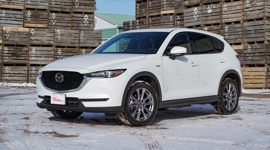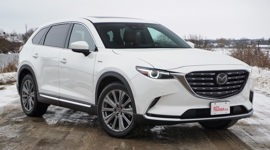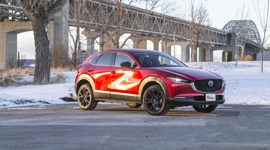Comparison Data
|
2021 Mazda CX-5 100th Anniversary Edition
|
2021 Mazda CX-9 Kuro Edition
|
|---|---|
|
Engine Displacement
2.5L
|
2.5L
|
|
Engine Cylinders
Turbo I4
|
Turbo I4
|
|
Peak Horsepower
227 hp @ 5,000 rpm
|
227 hp @ 5,000 rpm
|
|
Peak Torque
310 lb-ft @ 2,000 rpm
|
310 lb-ft @ 2,000 rpm
|
|
Fuel Economy
10.8 / 8.7 / 9.8 L/100 km cty/hwy/cmb
|
11.6 / 9.1 / 10.5 L/100 km cty/hwy/cmb
|
|
Cargo Space
875 / 1,687 L seats down
|
407 / 1,082 / 2,017 L behind 3rd/2nd/1st row
|
|
Base Price
$43,550
|
$50,150
|
|
A/C Tax
$100
|
$100
|
|
Destination Fee
$1,950
|
$1,950
|
|
Price as Tested
$45,600
|
$52,400
|
|
Optional Equipment
None
|
$200 – Polymetal Grey Metallic Paint, $200
|
Mazda is known for marching to the beat of its own drum, cranking out machines imbued with a sense of style when others are simply content to produce the vehicular equivalent of plain oatmeal.
Its refusal to swipe right on any of its competitors means Mazda largely sails solo in terms of parts sharing – particularly in terms of powertrain development. The company has relatively few engines in its corporate cupboard compared to larger automakers, limiting its underhood mix-and-match opportunities.
All of which helps explain why the brand’s two biggest crossovers, the two-row CX-5 and three-row CX-9, share the same mechanical parts, including their engines. We drove them back-to-back in an effort to try and determine if Mazda needs to hook up with a new dance partner.
Styling
Attempting to rate the styling of these two machines is like trying to choose between the Property Brothers on HGTV: both are handsome, with a lot of the same features. Mazda has done a great job honing its design language over the years, even managing to incorporate a dash of MX-5 into those ever-so-slightly arched front fenders. Both vehicles have handsome faces, which is refreshing in today’s sea of milquetoast me-too crossovers.
If there’s any distinction here at all, it’s around the back – and with that, our comparison with the Property Brothers comes to an abrupt end. The CX-9’s additional 150 mm (six in) of width is just enough to space those nicely sculpted taillights just a little too far apart, leaving too much visual mass across its hatchback. Mazda has attempted to offset this with a slim chrome-like spear connecting the lenses, but there’s no hiding the width of the bigger crossover.
CX-5: 8.5/10; CX-9: 8/10
Power
Mazda’s decision to install the same engine in vehicles of vastly different sizes was the very impetus for this comparison test. The two-row CX-5 weighs a not-insignificant 260 kg (573 lb) less than the three-row CX-9. Fun fact: this is about the same mass as an average male grizzly bear or a large vending machine, both of which can ruin one’s appetite (though only one is found offering overpriced snacks in airport terminals).
Toss in the possibility that the CX-9 may be carrying more passengers – after all, that is why you bought a three-row crossover, right? – and there’s a good chance it’ll be hauling around even more weight than its smaller sibling. Unfortunately, it’s simply too much for the turbocharged 2.5L four-cylinder to move comfortably, sending it much more frequently into the tachometer’s deep end when the driver calls down to the engine room for more power.
CX-5: 9/10; CX-9: 7/10
Driving Feel
Owners of the larger Mazda will find themselves probing the outer reaches of accelerator pedal travel in order to make any sort of meaningful forward progress – especially when the vehicle is laden with passengers and their detritus. Extra mass dents acceleration, but it also affects handling. While the CX-9 is certainly superior in this capacity compared to many of its competitors, your author couldn’t shake the feeling that driving the larger of this pair was like driving a CX-5 that was wearing a thick set of boots. All the motions took more effort and were less precise.
CX-5: 8/10; CX-9: 6/10
Features
This particular CX-5 was loaded to the gunwales with heated and ventilated front chairs, heated outboard rear seats, and a Bose-branded premium audio system. A mail slot of a sunroof appeared overhead, looking small compared to the panoramic units found on other vehicles in this segment.
Despite sitting two notches from top-tier status in the 2021 pecking order, this Polymetal Grey CX-9 was equipped with all manner of driving helpers such as stop-and-go adaptive cruise control and lane keeping. A dozen speakers stand ready to emit “Baby Shark” or CBC (your choice), and seating is similarly climate-controlled as the smaller CX-5.
CX-5: 8/10; CX-9: 8/10
User Friendliness
Both vehicles get good marks for clearly communicating to the driver via an instrument cluster with gauges the size of dinner plates. The speedometer is a reconfigurable screen, able to populate with trip information or a fuel economy readout. An angry red mark, not unlike those which used to routinely appear on your author’s English lit exams, pops up on the appropriate numeral as an indicator of the current speed limit – a handy feature on unfamiliar roads.
It will surprise no one that Mazda employs broadly the same parts and pieces in the cabin of both CX-5 and CX-9. Heating and ventilation is controlled via crisp dials which feel more expensive than the sticker price suggests; in fact, nothing in either interior feels particularly cheap or cut-rate.
We will take the opportunity to kvetch about Mazda’s insistence of funnelling all infotainment controls through a multifunction dial on the centre console, at least while in motion. At rest, the tablet-style screens in each may be controlled by touch. The company has a good point about driver distraction, but we challenge anyone to quickly jump through the satellite radio channels using the existing setup. Hey, at least there’s a real volume knob.
CX-5: 8/10; CX-9: 8/10
Practicality
With an extra 200 L of cargo space behind the second row, the CX-9 is objectively the more practical of these two machines. It can tow 1,588 kg (3,500 lb), handily outstripping the CX-5, which can only haul 907 kg (2,000 lb). The latter is surprising given the propensity of its competitors to schlep nearly twice that amount. The CX-5 has an ace up its sleeve in the form of a 40/20/40-split folding second row, however, permitting owners to simply fold the centre section for transporting long items while still offering a comfortable seating arrangement for a quartet of humans.
CX-5: 8/10; CX-9: 8.5/10
Comfort
The 100th Anniversary Edition is a new top trim which includes features of the snazzy Signature model but adds attractive red leather seats and contrasting white interior detail. It also adds $1,500 to the Signature’s price tag. The leather upholstery is buttery soft, making the seats all-day comfortable even for this long-of-limb author. Second-row urchins will find much to like in terms of legroom and USB outlets. This is also the first vehicle in recent memory to feature red carpet – a delightful departure from dour blacks and greys.
These compliments carry over to the CX-9, where our Kuro edition was also fitted with natty red leather. This new-for-2021 trim has second-row captain’s chairs as standard equipment, though one needs to make a $1,700 walk to the Signature series if they desire a console between these thrones. We’ve docked the CX-9 half a point compared to the CX-5 because, as with most three-row crossovers, space in the way back is only habitable by Oompa Loompas for anything longer than a trip across town.
CX-5: 9/10; CX-9: 8.5/10
Fuel Economy
Straight up, the CX-5 gets better fuel economy than the CX-9. Basic thermodynamics teaches us the same engine, working harder in a heavier application, will consume more gasoline. The delta isn’t huge; less than 1.0 L/100 km in both city and highway driving – but the extra costs will add up over time.
CX-5: 8.5/10; CX-9: 7.5/10
Value
Both are well-priced compared to their immediate competition, especially when one considers the materials with which Mazda has used to craft interior accommodations. It should be noted that entry-level trims of the CX-9 are priced nearly $10,000 below our test unit yet still contain much of the same equipment and are propelled by the same powertrain. Meanwhile, if a turbocharged CX-5 is your goal, one is advised to sample the turbo GT trim. It’s priced $3,750 south of the 100th Anniversary model and its amenities are legion.
CX-5: 8/10; CX-9: 8/10
The Verdict
There’s no doubt that Mazda’s 2.5L turbocharged engine is a great mill... in the CX-5. It’s responsive and punchy, adding a bit of mouth to match its stylish trousers. Plunked between the CX-9’s fenders, that same gas-burner turns into a rowdy partner that’s out of its element. Absent any sort of manufacturing dance partner with which it can share technology – think Toyota borrowing engines from Subaru for the 86 or BMW for the Supra – Mazda doesn’t currently have a bigger arrow in its quiver, and it suffers as a result.
This is unfortunate since the CX-9 is let down only by its engine. Unless the extra cargo or passenger space is truly needed, the smaller CX-5 provides an equally attractive interior and hefty dose of style while making better use of this turbocharged powerplant.
Now, if you’ll excuse us, Jon and Drew are about to remodel a three-bedroom bungalow in suburban Vancouver.
